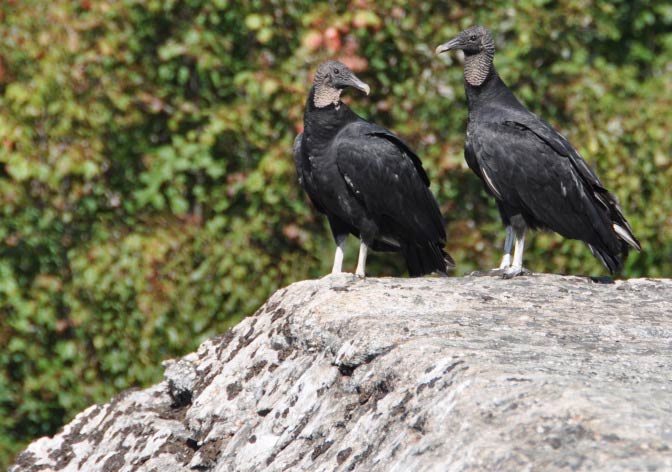
Black vultures at Mohonk Preserve. (Photo by Cornelia DeDona)
Black vultures are the most populous vulture in the Western Hemisphere, but they’re relatively new to New York State. Here are some things to keep in mind next time you see a dark shape circling above.
Scientists aren’t sure why they’re moving north.
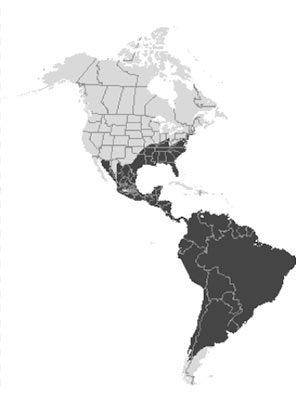
The black vulture’s range
Up until the mid-20th century, the black vulture ranged from South America to Virginia. Since then, it’s continued to move north, nesting in New Jersey in the 1980s and New York in the 1990s. Some believe global warming could be a factor, but Kevin McGowan, an ornithologist at the Cornell Lab of Ornithology, says that’s not always the case when an animal moves north. He pointed out that recent surveys show just as many bird species moving south as north.
Other possible factors include increased food availability, especially more deer roadkill, phasing out of DDT, and changing attitudes about vultures. “It used to be legal and socially acceptable to shoot vultures,” said McGowan.
The first breeding nest was discovered on the Mohonk Preserve, and that’s still one of the best places to spot one.
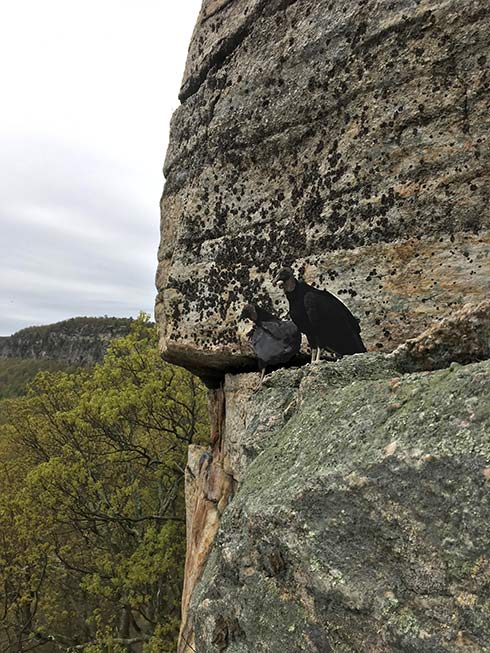
Photo by Marty Molitoris, a guide with Alpine Endeavors, taken on the climbing route P38. “For awhile they were rare, you’d just see one or two here and there,” he said. “Now they’re just all over the place. I love seeing them. I think they’re incredible.”
Former research associate at the Mohonk Preserve Joe Bridges discovered a nest on the eastern side of Bonticou Crag in 1997 while climbing. “I saw a black vulture sitting on a rock at ground level and I thought it was curious,” he remembers. “And shortly after that I looked at a hole between two rocks and saw another black vulture, and that one moved back in a few minutes and I saw two eggs on the ground.” He didn’t realize it at the time, but he’d just observed the first breeding pair of black vultures in New York State.
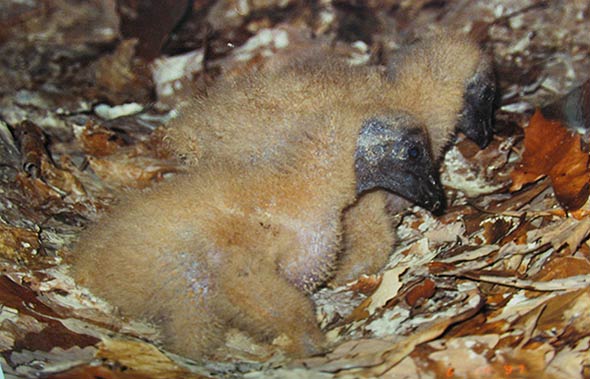
Chicks in a nest at Mohonk Preserve. (Photo by Joe Bridges.)
Today, hikers at Bonticou Crag and at other parts of the preserve often get a close look at both black and turkey vultures, sitting on rocks and in trees surveying the valley below, and gliding at eye level, taking advantage of the thermals created by the Shawangunk Ridge’s steep rise.
They let turkey vultures lead them to food, then team up to chase them away.
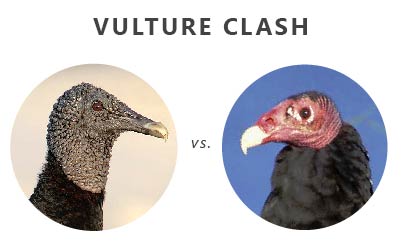 Turkey vultures can smell carrion from over a mile away. Black vultures, who have a limited sense of smell, fly above turkey vultures and wait for them to discover food and follow them to the carcass. Turkey vultures are larger than black vultures, but they’re no match for a group working together.
Turkey vultures can smell carrion from over a mile away. Black vultures, who have a limited sense of smell, fly above turkey vultures and wait for them to discover food and follow them to the carcass. Turkey vultures are larger than black vultures, but they’re no match for a group working together.
Although the turkey vulture is on the losing end of these interactions, so far there’s no sign it’s affecting their population numbers which, like the black vultures, continue to increase. It seems there’s enough roadkill to go around.
They’re not closely related to Old World vultures.

A griffon vulture
They share the name, bald head, circling flight and highly acidic digestive system, but New World vultures like the black vulture, turkey vulture and California Condor aren’t closely related to Old World species like the griffon and Egyptian vultures. Their common vulture characteristics are a result of traits selected for a similar lifestyle. New World vultures are actually more closely related to storks, with which they share a foul, though effective, means of thermoregulation. (See next entry.)
To cool off, they defecate on their legs.
Humans sweat. Dogs pant. New World vultures… have another means of generating moisture to affect evaporative cooling. It’s called urohidrosis, from the Greek for “urine” (uro) and “hidrosis” (sweating).
They sometimes prey on live animals.
Some Native American tribes called the turkey vulture “peace eagle” because it survives without killing. That’s not true of the black vulture, which is known to sometimes prey on weak and newborn live animals. The frequency of this behavior is disputed. Ranchers in some states estimated tens of thousands of dollars in annual losses, while scientists question how many of these cases are due to coyotes or death by other means. “It’s possible but man, they’re just not made to be predators,” said McGowan, the Cornell ornithologist. Vultures lack talons and their bills are made to pick, not kill. “They’re not really capable of delivering a convincing killing blow.”
They can be destructive.
When black vultures roost in a populated area they can cause problems. They’ve been known to pick at and destroy rubber roofing materials, shingles, screen doors, windshield wipers and sunroof gaskets. Scientists aren’t sure why they do this. They don’t collect the material or use it to build nests. They just tear it. One explanation could be that they’re just inherently curious about certain man-made materials, and the destruction is a form of play.
They’re very social.
Curiosity and sociability often come together. So it is with the black vulture. In addition to working together when feeding, they spend much of their time together, often roosting in large numbers. Related birds stick together and preen one another, while most fights seem to be between non-kin.
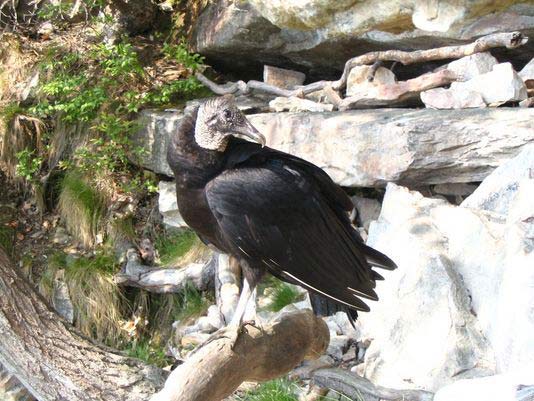
(Photo by Bob Elsinger)
How to tell the difference between black and turkey vultures.
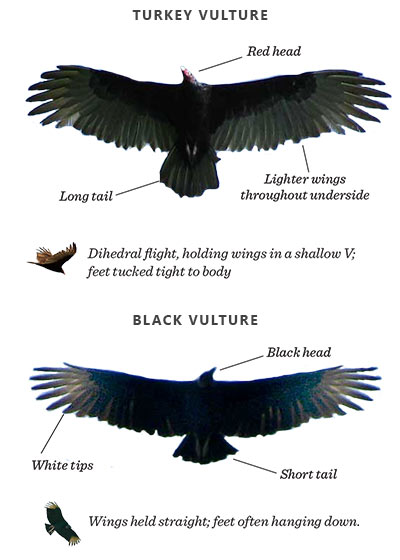
Turkey vultures: Slightly larger, red head, legs held tight to body, wings form shallow-V in flight, less flapping, silvery wings when viewed from beneath.
Black vulture: Smaller, black head, legs often hanging down, wings held straight in flight, more flapping, wings black except white patch on tips when viewed from beneath.

I have noticed the turkey vulture in mass numbers in upstate ny, but this info ive read so far is very interesting, these birds are another amazing creature to respect. I can really dig the term PEACE VULTURE . much can be learned from observing the many species that share this planet with us, not the other way around.
Update jun 2018 2 young Black Vultures spotted in Geneseo, NY (not far from Buffalo, Niagara Falls or Rochesster)
2 vultures spotted in Melville, NY on top of commercial building
Had two American black vultures in Speigletown 8/28/18
Took pics as one sat on the ground
I found out from first hand experience that the Black-headed vultures prey on weak animals when a pair of them that had previously visited my yard returned months later with two more in tow and went after a sickly cat of mine who was resting in the driveway. I chased them with a broom and let them know they are NOT welcome here any longer. That was over a year ago and they have never been back.
Sept 13, 2018 – Copake, NY
3 Large black vultures hanging around my house – on deck, roof – unfazed!
When I hears ab animal moving around coming from above ceiling I thought squirrels had gotten into my attic again – which costs thousands to remove and remove and replace torn up insulation – a few years ago.
I read black vulture sometimes lift off roof tiles and make holes –
Now I’m wondering if it was the vultures I heard the last few days , and if they’ll just move on
– or if I now have a squirrel + vulture infestation.
I’m moving back to the city!
The African Turkey Vulture (as I was told it was called) makes home on Cherry and Myrtle Streets up the street from Tillson Lake, Hamlet of Wallkill on Fringe of Gardner. They are a vigilant presence, flying to the Gunk’s each day to hang out and never failing to return at night. They are an eerie site especially since they tend to rest in large numbers together in the tall pines, on roof tops or fences.
I have first hand seen these birds hunt rats in hay fields. Last year I saw an entire flock descend upon the same hay field while it was being cut. There must’ve been 30 or more birds landing on rats and picking them up and flying away with them. It reminding me of a scene out of The Wizard of Oz. Very creepy! However, they are cool birds, a huge colony lives in the town I live in.
There are about 30 or more living on the East side of Amsterdam NY. I believe they mostly feed off the Mohawk River. They seem to be congergating in a large pine tree close to my house on the corner of Summit Ave. and Glen Ave. Should our local officials be notified of the large numbers?
This is crazy to me how rare it sounds to spot a black vulture. I literally have about 20 or 25 living in my neighborhood and they tend to love sitting on the fence and barbecue grill in my back yard. They don’t seem menacing or mean. On the contrary, they don’t move away quickly when I come outside. It seems like they want to see what I’m doing!!!
The Eastern Bluebird is the State bird of New York.
Eight states have two State birds.
New York should make the Black Vulture its second state bird, and make that nine states with two birds.
Two black vultures spotted in Gloversville New York today.
The one thing to know about black vultures is that New Paltz hates the creatures and does everything possible to destroy these birds’ roosts. Cutting down trees, razing high buildings and hanging their dead corpses around roof tops are all techniques used in New Paltz over the last 12 years to no success. If the birds’ new roost wasn’t the top of the Middle School building, the municipality would probably tear that down too?
It’s the lay of the land and the up-drafts of wind that keep the black vultures aloft, and North Manheim Street has it all. No wonder North Manheim is named after a German city.
It’s amazing that this thread, bless its soul, is ressurected every few months…
Got me thinking about how the American Wild Turkey was almost our national bird. Good ‘ole Tommy-Boy lost (by a single vote) to the more regal (but still a scavenger) Bald Eagle. Ironically, both black vultures and black eagles are scavengers–so they’re kinda relatives.
There’s a Thanksgiving table I’m glad not to be at.